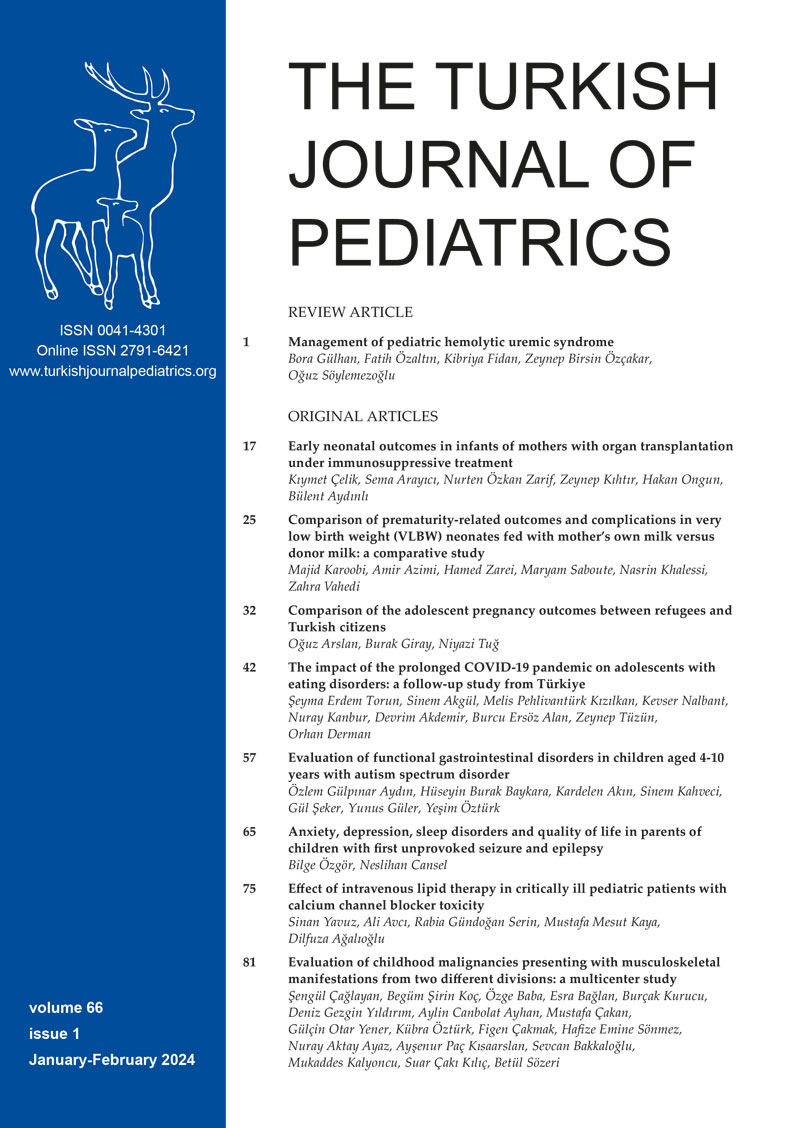Abstract
Background. Campotodactyly-artrhropathy-coxa vara-pericarditis (CACP) syndrome is a very rare autosomal recessive genetic disorder. It is characterized by flexion contracture of the fifth finger (camptodactyly); non-inflammatory arthropathy; decreased angle between the shaft and the head of the femur (coxa vara) and pericarditis. Its association with mitral stenosis has not yet been reported. Hereby we report this unique association with CACP syndrome.
Case. An eleven-year-old girl presented with non-productive cough, dyspnea, and orthopnea. She was diagnosed CACP syndrome at the age of seven and a biallelic frameshift mutation in the PRG4 gene was determined. The physical examination revealed pectus excavatum, camptodactyly, genu valgum, tachypnea and orthopnea. The functional capacity was NYHA III-IV. She had 2/6 soft pansystolic murmur at 4th left intercostal space and a rumbling diastolic murmur at apex. Echocardiography revealed an enlarged left atrium, severe stenotic mitral valve with a mean diastolic transmitral gradient of 22.5 mmHg, mild mitral regurgitation and mild apical pericardial effusion. The patient had mitral comissurotomy and partial pericardiectomy operation. Her post-operative transmitral gradient decreased to 6.9 mmHg and the pulmonary pressure was 30 mmHg. Her functional capacity increased to NYHA I-II.
Conclusions. The main defect is the proteoglycan 4 protein which acts like a lubricant in articular and visceral surfaces. Therefore, the leading clinical feature is arthropathy. Cardiac involvement other than clinically mild pericarditis is not usually expected. Three types of proteoglycans (decorin, biglycan, and versican) are present in the mitral valve. This could be the reason of mitral valve involvement in rare cases as like ours. It is important that these patients undergo echocardiographic examination regularly.
Keywords: arthropathy, camptodactyly, coxa vara, PRG4 gene, mitral stenosis
References
- Taşar M, Eyileten Z, Kasımzade F, Uçar T, Kendirli T, Uysalel A. Camptodactyly-arthropathy-coxa vara-pericarditis (CACP) syndrome. Turk J Pediatr 2014; 56: 684-686.
- Yilmaz S, Uludağ Alkaya D, Kasapçopur Ö, et al. Genotype-phenotype investigation of 35 patients from 11 unrelated families with camptodactyly-arthropathy-coxa vara-pericarditis (CACP) syndrome. Mol Genet Genomic Med 2018; 6: 230-248. https://doi.org/10.1002/mgg3.364
- Choi BR, Lim YH, Joo KB, et al. Camptodactyly, arthropathy, coxa vara, pericarditis (CACP) syndrome: a case report. J Korean Med Sci 2004; 19: 907-910. https://doi.org/10.3346/jkms.2004.19.6.907
- Ciullini Mannurita S, Vignoli M, Bianchi L, et al. CACP syndrome: identification of five novel mutations and of the first case of UPD in the largest European cohort. Eur J Hum Genet 2014; 22: 197-201. https://doi.org/10.1038/ejhg.2013.123
- Kisla Ekinci RM, Balci S, Dogan H, et al. Camptodactyly-arthropathy-coxa vara-pericarditis syndrome resembling juvenile idiopathic arthritis: a single-center experience from southern Turkey. Mol Syndromol 2021; 12: 112-117. https://doi.org/10.1159/000513111
- Peters B, Schuurs-Hoeijmakers JH, Fuijkschot J, et al. Protein-losing enteropathy in camptodactyly-arthropathy-coxa vara-pericarditis (CACP) syndrome. Pediatr Rheumatol Online J 2016; 14: 32. https://doi.org/10.1186/s12969-016-0093-5
- Johnson N, Chaudhary H, Kumrah R, et al. Syndrome of progressive deforming non-inflammatory arthritis of childhood: two patients of camptodactyly-arthropathy-coxa vara-pericarditis syndrome. Rheumatol Int 2021; 41: 1875-1882. https://doi.org/10.1007/s00296-020-04688-0
- Madhusudan S, Gupta A, Prakash M, Matta D, Suri D, Singh S. Camptodactyly-arthropathy-coxa vara-pericarditis (CACP) syndrome: a mimicker of juvenile idiopathic arthritis. Scand J Rheumatol 2016; 45: 77-78. https://doi.org/10.3109/03009742.2015.1085085
- Grande-Allen KJ, Calabro A, Gupta V, Wight TN, Hascall VC, Vesely I. Glycosaminoglycans and proteoglycans in normal mitral valve leaflets and chordae: association with regions of tensile and compressive loading. Glycobiology 2004; 14: 621-633. https://doi.org/10.1093/glycob/cwh076
- Gupta V, Barzilla JE, Mendez JS, et al. Abundance and location of proteoglycans and hyaluronan within normal and myxomatous mitral valves. Cardiovasc Pathol 2009; 18: 191-197. https://doi.org/10.1016/j.carpath.2008.05.001
Copyright and license
Copyright © 2024 The Author(s). This is an open access article distributed under the Creative Commons Attribution License (CC BY), which permits unrestricted use, distribution, and reproduction in any medium or format, provided the original work is properly cited.















